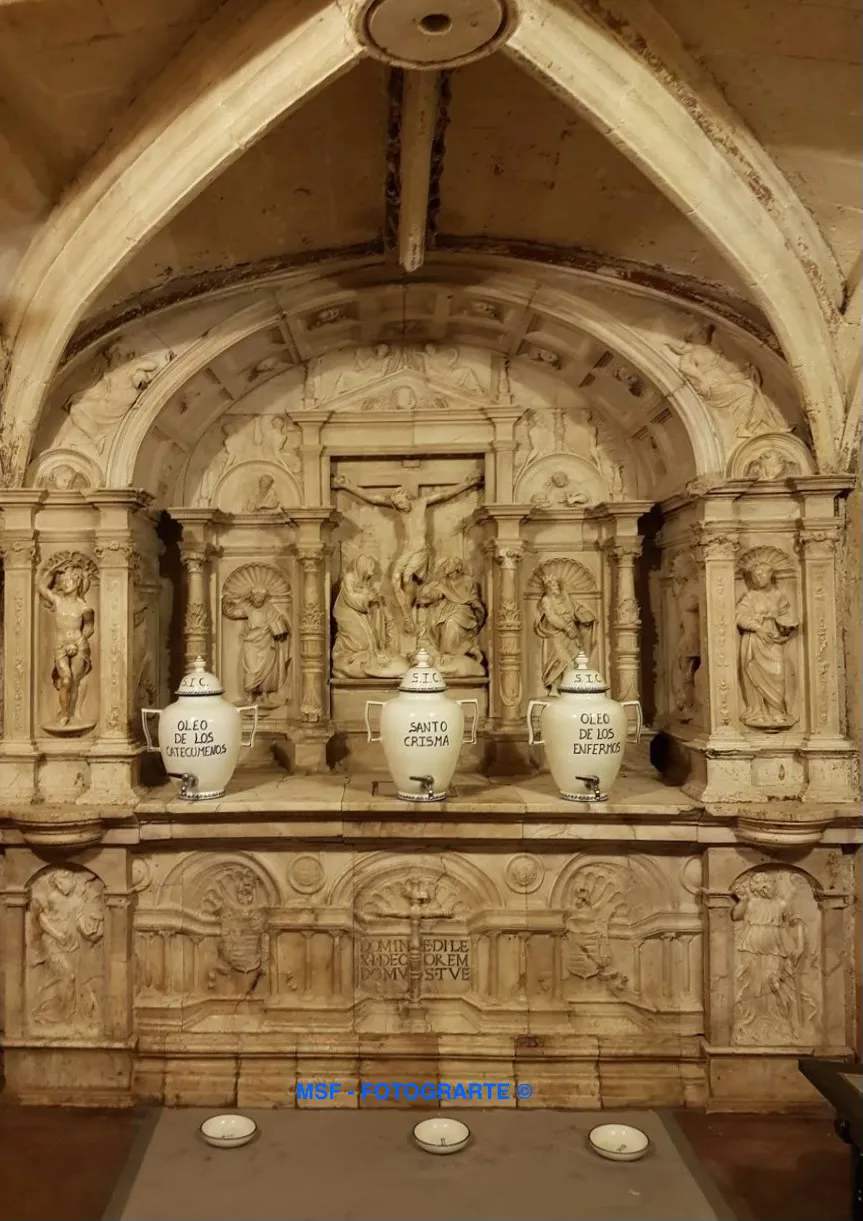
De reducido tamaño está situada en el trasaltar y fue realizada en 1541 por Jacques Luquin en mármol, siendo su fundador Don Diego Fernandez de Argote, que está enterrado en la misma capilla.
Wikipedia nos señala que:
El retablo de la capilla, construido en mármol blanco, fue realizado en 1541 por Jacques Luquin. El arcosolio del retablo se asienta sobre dos bellas pilastras, profusamente decoradas con relieves en los que se hallan representados San Sebastián, Santa Lucía, San Miguel Arcángel y Santa Catalina. El cuerpo del retablo distribuye su espacio en tres calles. En la calle central se encuentra una representación del Calvario, y en las calles laterales se encuentran representados San Bernabé, titular de la capilla, y San Martín. En el frontón curvo del retablo se hallan los bustos de San Pedro y San Pablo.
La mesa de altar del retablo de la capilla cuenta con una inscripción latina en medio del canto, y en ella se hallan representadas dos de las virtudes en los basamentos sustentadores de las pilastras laterales. Cuenta la mesa de altar con unas delicadas combinaciones de arquerías y heráldicas fundacionales en los recuadros del centro.
Constituye una de las obras más representativas del Renacimiento en Córdoba:
Este rico programa iconográfico nos presenta, junto al habitual Calvario, los santos de devoción del comitente; pero de manera inteligente se unen San Bernabé y San Matías a los príncipes de los Apóstoles, porque, no lo olvidemos, San Bernabé fue acompañante de San Pablo y San Matías fue elegido, por iniciativa de San Pedro, como sustituto del malogrado Judas, para completar el imprescindible número de doce apóstoles [Hch 1, 15-26].
La inscripción del altar está tomada del salmo 26, 8, y puede traducirse como amo, Yahveh, la belleza de tu Casa. Es una declaración de fe del fundador, que, habiendo de ser sepultado en ese espacio, se preparaba ya en vida para gozar de la gloria del Cielo. Con ello, además, se nos recuerda la relación directa que existe entre el templo terreno y la Jerusalén Celeste. En efecto, cuando contemplamos los templos cristianos, nos engañaríamos si pensáramos que su belleza, grandiosidad y riqueza se debe solo a un deseo de vanagloria o jactancia por parte del comitente. Es cierto que, en algunos casos, existía una determinada voluntad de emulación. Pero, por encima de todo, se trataba de dedicar omnia ad maiorem Dei gloriam, es decir, todo a la mayor gloria de Dios. Este es, como sabemos, el lema de los jesuitas, pero ha sido también, en la práctica, una constante en la fecunda historia del arte cristiano, que ha sabido, con ello, a lo largo de los siglos, crear cotas de belleza y esplendor inigualables en toda la historia del Arte; y todo, para dar una imagen de la gloria del Cielo (…).
Small in size, it is located in the rear altar and was made in 1541 by Jacques Luquin in marble, whose founder was Don Diego Fernandez de Argote, who is buried in the chapel.
Wikipedia describes the little but extraordinary chapel:
The altarpiece of the chapel, built in white marble, was made in 1541 by Jacques Luquin. The arcosolium of the altarpiece rests on two beautiful pillars, profusely decorated with reliefs depicting Saint Sebastian, Saint Lucy, Saint Michael the Archangel and Saint Catherine. The body of the altarpiece is divided into three sections. In the central section there is a representation of Calvary, and in the side sections there are representations of Saint Barnabas, the patron saint of the chapel, and Saint Martin. On the curved pediment of the altarpiece there are busts of Saint Peter and Saint Paul.
The altar table of the altarpiece of the chapel has a Latin inscription in the middle of the edge, and two of the virtues are represented on the bases supporting the side pillars. The altar table has some delicate combinations of arches and founding heraldry in the central panels.
The web from Córdoba’s diocese tells us something more about the significance of this little chapel:
This rich iconographic programme presents us, along with the usual Calvary, with the patron saints; but in a clever way, Saint Barnabas and Saint Matthias are joined to the princes of the Apostles, because, let us not forget, Saint Barnabas was the companion of Saint Paul and Saint Matthias was chosen, on the initiative of Saint Peter, as a substitute for the ill-fated Judas, to complete the essential number of twelve apostles [Acts 1, 15-26].
The inscription on the altar is taken from Psalm 26, 8, and can be translated as I love, Yahweh, the beauty of your House. It is a declaration of faith by the founder, who, having to be buried in that space, was already preparing himself in life to enjoy the glory of Heaven. With this, we are also reminded of the direct relationship that exists between the earthly temple and the Heavenly Jerusalem. Indeed, when we look at Christian temples, we would be deceiving ourselves if we thought that their beauty, grandeur and richness were due only to a desire for vainglory or boasting on the part of the commissioner. It is true that, in some cases, there was a certain desire for emulation. But, above all, it was a question of dedicating omnia ad maiorem Dei gloriam, that is, everything to the greater glory of God. This is, as we know, the motto of the Jesuits, but it has also been, in practice, a constant in the fruitful history of Christian art, which has thus managed, over the centuries, to create levels of beauty and splendour unequalled in the entire history of art; and all, to give an image of the glory of Heaven (…).

